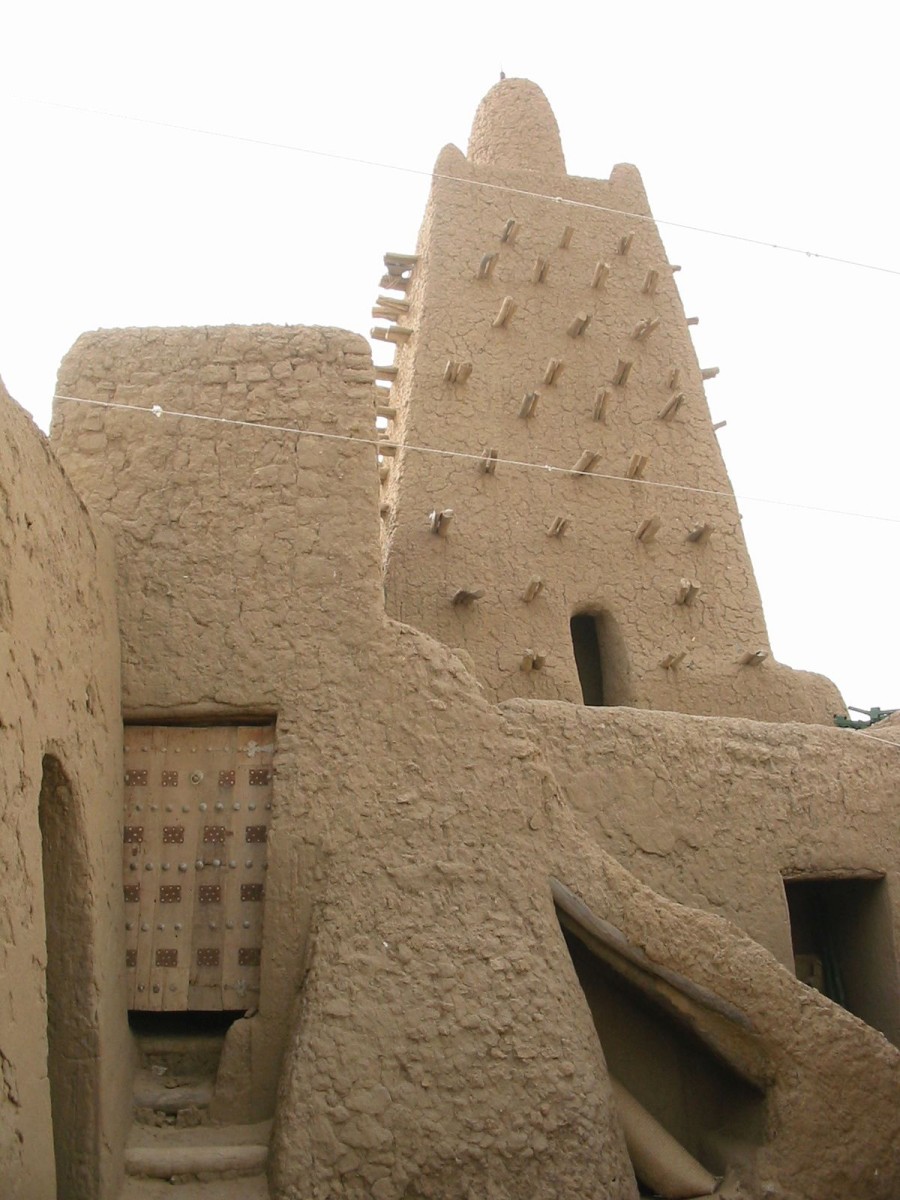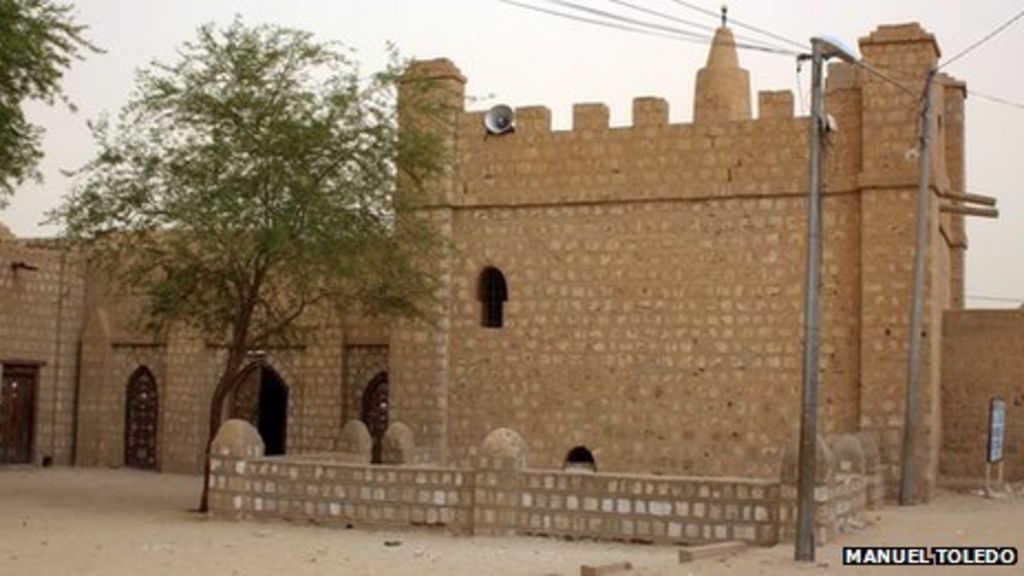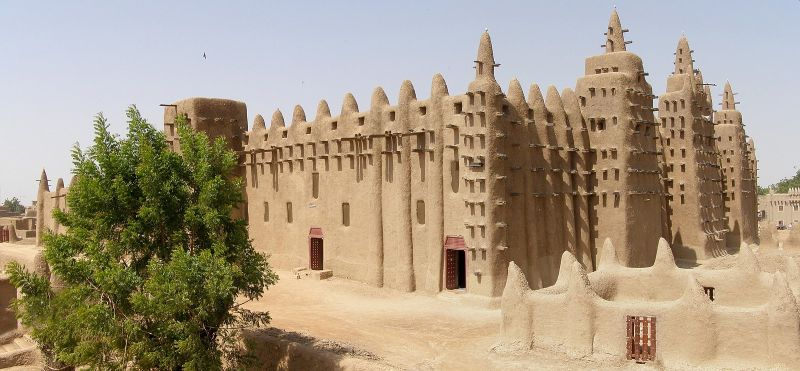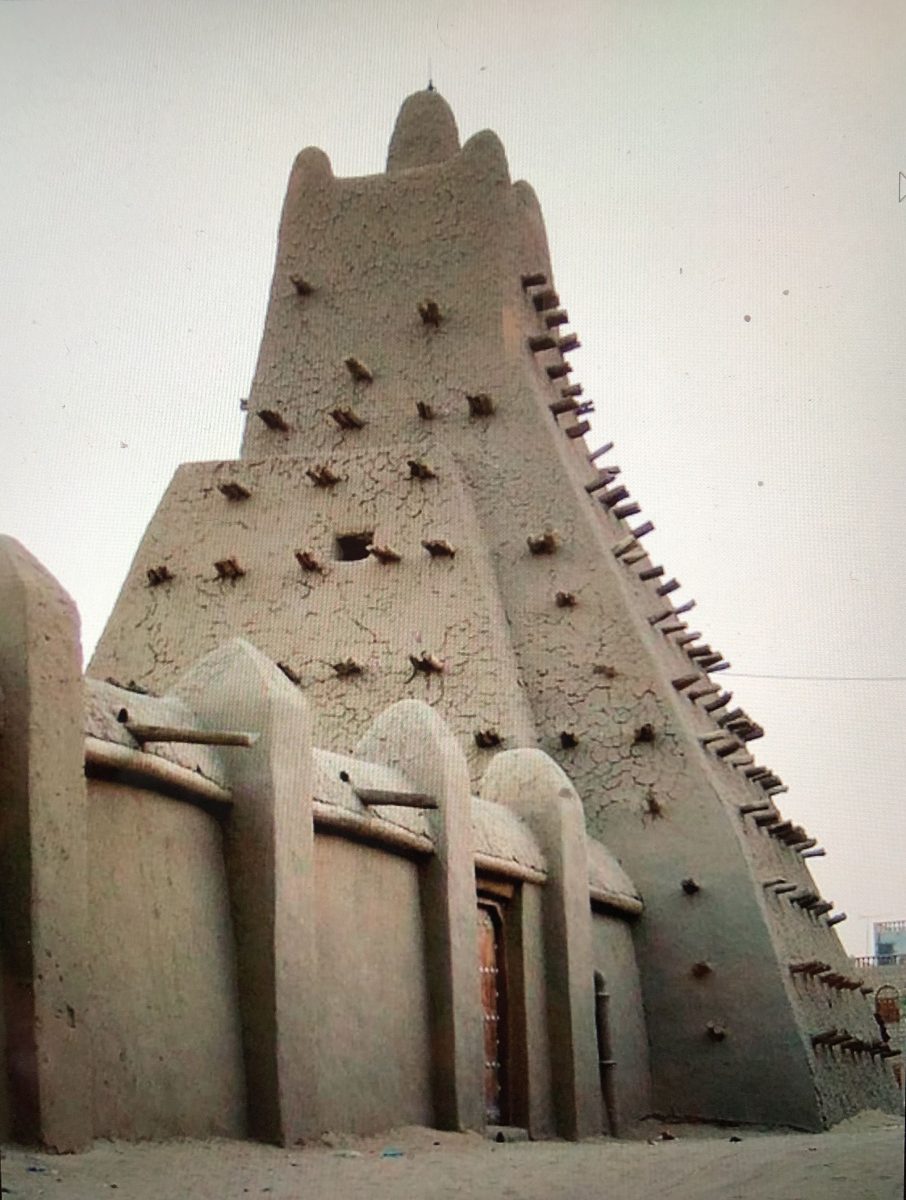Use these topics to jumpstart research!
Slideshow
 Friday Mosque of Chinguetti |
Friday Mosque of Chinguetti 13th century, Chinguetti, Mauritania
“Surrounded and sometimes nearly engulfed by the shifting dunes of the western Sahara, Chinguetti was established in the thirteenth century and is considered one of Islam’s seven holy cities. A World Heritage Site, the town flourished in the Middle Ages, when it was a key stop for caravans carrying gold, salt, dates, and ivory across the Sahara. Chinguetti is also home to an extraordinary collection of important Islamic manuscripts. Its medieval mosque features a prayer room with four aisles, a double-niched mihrab, and a courtyard. It is best known for its massive square minaret that towers over the town…” World Monuments (https://www.wmf.org/project/chinguetti-mosque).
|
|
|
Sankore Mosque 15th century, Timbuktu, Mali
“One of the two historic mosques of Timbuktu (the other being the Jingereber), the Sankore mosque was built during the declining years of the Empire of Mali, in the early 15th century A.D. Architecturally, it is remarkable for its large pyramidal mihrab. But this is not its real claim to fame — indeed, it is smaller and less intricate than earlier Malian mosques including the 13th century mosque of Djenne. Instead, it is famous for being the center of the great Islamic scholarly community at Timbuktu during the 16th century A.D. The medieval “University of Timbuktu,” often referred to as the “University of Sankore” was very different in organization to the universities of medieval Europe….” (K.C. MacDonald, Sankore Mosque. The Road to Timbuktu, PBS.org)
|
 Djinguereber (Djingareyber) Mosque |
Djinguereber Mosque 1324–1327, Timbuktu, Mali
The Djingareyber Mosque, the initial construction of which dates back to Sultan Kankan Moussa, returning from a pilgrimage to Mecca, was rebuilt and enlarged between 1570 and 1583 by the Imam Al Aqib, the Qadi of Timbuktu, who added all the southern part and the wall surrounding the cemetery located to the west. The central minaret dominates the city and is one of the most visible landmarks of the urban landscape of Timbuktu. https://whc.unesco.org/en/list/119/
|
 Sidi Yahya Mosque
|
Sidi Yahya Mosque 1440, Timbuktu. Mali
Sidi Yahya is a mosque and madrassa of Timbuktu in the West African country of Mali which finished construction in 1440….Sidi Yahya is named for its first imam and head professor Sidi Yahya (also called Sidi Yahya Tadelsi or Sidi Yahya Al Andulusi). The mosque is located south of the more famous Sankoré Mosque. Construction of the Sidi Yahya mosque was begun in 1400 by Sheikh El-Mokhtar Hamalla in expectation of a great holy person. It took 40 years to complete. In 1441 Mohamed Naddah, the city-governor of Timbuktu, appointed his close friend Sidi Yahya as its first imam. This marked the beginning of the mosque as a madrassa and a great center of learning for the region (The Gold Road)
|
 Great Mosque, Djenne
|
Great Mosque of Djenne, Mali
“The current Great Mosque of Djenne, although a UNESCO World Heritage site and one of the great architectural wonders of Africa, is not the original mosque of Djenne. The first Great Mosque of Djenne was built in the 13th century by Koy Konboro — Djenne’s first Islamicized ruler. As a vivid expression of his new-found faith, Koy Konboro had his palace destroyed, and the first Great Mosque built in its place. For six centuries, this massive mosque, comparable in size to the current Great Mosque, dominated the center of the town….in 1906-1907 the current Great Mosque of Djenne was built on the site of the first Great Mosque in the monumental Sudanic style and has ever since remained the visual symbol of the town… (K.C. MacDonald, Sankore Mosque. The Road to Timbuktu, PBS.org).
|
 Gidan Rumfa Palace |
Gidan Rumfa 15th century, the Emir’s Palace at Kano, Nigeria
“The Emir’s Palace at Kano, which today continues to define the axis of the city, was built in the fifteenth century by Sarkin Rumfa (also Rimfa). Rumfa transformed the fabric of Kano, and was said to be the author of twelve innovations in Kano, including the palace and the Kurmi market, according to the Kano Chronicle. However, before the erection of the Gidan, or Dakin, Rumfa (sic. House of Rumfa), there existed a palace, the south gate of which now serves as the passage from the Sarkin’s private courtyard to the royal graveyard. The 33-acre palace continues to house about 1,000 people in some of the most desirable housing in Kano” https://www.archnet.org/sites/3778.
|
 Larabanga Mosque
|
Larabanga Mosque c. 1421, Larabanga, Ghana
“Built primarily from packed earth, Larabanga is Ghana’s oldest mosque, and one of the country’s most revered religious sites. The seventeenth century structure’s style was heavily influenced by western Sudanese architecture, characterized by the use of horizontal timber, pyramidal towers, buttresses, and triangular perforations over entry portals. It is one of only eight mosques in the country built in this manner, and has long been a pilgrimage site for Ghana’s Muslim population. The northwest corner of the building features a minaret and a mihrab, a niche in the mosque wall at the point nearest to Mecca, toward which the congregation faces to pray” (World Monuments Fund).
|
|
|
|
|
Photos: Wikimedia Commons, Public Domain
|
|
|
|

